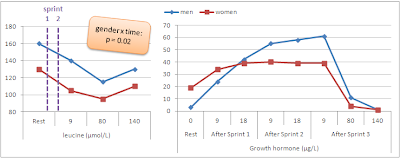The advantages of HIIT reach well beyond fat loss, but...
Moreover, a 2011 study by Naito et al., the results of which I have discussed in November 2011, shortly after it was published in Acta Physiologica (cf. "HIT Your Satellite Cells to Increase Your Gains"), already hinted at the fact that the advantages of HIIT reach well beyond its fat-burning effects. Yet although the increase in both satellite cell count and incorporation into the muscle Naito et al. observed speak for themselves, there's still rumors going round that this training style could be catabolic. In that the argument usually revolves around the notion that muscle damage is a major driving force of satellite cell recruitement and that if the latter is a necessary consequence of HIIT it would counter your efforts to build muscle. Now, aside from the fact that this argument is intrinsically flawed (I mean, what to you do in the gym, when you weight train? You break down muscle tissue!), a recently published study from the famous Karolinska Institute in Stockholm, Sweden, attests to the fact that the exact opposite is the case.
... it appears as if women could derive even greater benefit from all-out sprinting than men
 |
| Image 2: The exercise stimulus in the study was a Wingate test, one of standard procedures in exercise science. |
To this ends, the scientists recruited nine men and eight women who despite participating in leasure time sports were only "in good shape" and not considered to be athletes. For the experiment the subjects reported to the lab fasted and, after a brief 1min warm-up, performed the well-known Wingate-test, which consists of three consecutive 30s all-out sprints with 20min breaks between the intervals on a braked cycle ergometer (average peak power was ~645W and ~935W for women and men, respectively, on a per-lean body-mass base, the peak and mean power was yet identical)
 |
| Figure 1: Illustration of the experimental protocol used in the study. |
 |
| Figure 2: Phosphorylated AKT, mTOR, p70S6K and rpS6 (a.u.) in male and female study participants before the first and 140min after the third sprint of the Wingate test (data adapted from Esbjörnsson. 2012) |
Do women just make better use of the same stimulus?
As far as the phosphorylation of p70S6K, of which the current scientific evidence suggests that is a more appropriate measure of the "real-world" protein synthetic effect of mTOR, a completely different picture emerges. While the +43% increase in the male subjects is just about statistically significant (p = 0.04), the +222% increase in p-p70S6K in the female subjects appears to confirm what Esbjörnsson et al. already had suspected.
 |
| Figure 3: Serum leucine and growth hormone levels at rest and after the sprints (data adapted from Esbjörnsson. 2012) |
- Lower accumulation of lactate and ammonia and a faster recovery of ATP levels in type II fibers of women than men
- Lower levels of plasma catecholamins (=stress hormones) in response to sprint exercises in women than in men
- Slower disappearance of leucine and thusly more sustained elevation of protein synthesis in women than in men
An alternative explanation, which would, by the way, have real-world implications for the training practice, is (and I prefer to cite this, to avoid being accused of sexism) that...
women do not exhaust themselves as much as men during each bout of exercise and thereby elicit a smaller activation of AMPK, resulting in less inhibition of mTOR.In view of the fact that previous studies by Esbjörnsson et al. refute this hypothesis, it appears unlike that an "over-expression" of AMPK, of which I have discussed in one of the previous installments of the Intermittent Thoughts that its locally expressed alpha-2 isoform does not inhibit the exercise induced increase in protein synthesis, anyway, could explain why similar exercise stimuli (peak and mean power per fat-free mass were virtually identical for men and women) and within the statistical margin identical mTOR responses induce a more pronounced protein synthetic response in women than in men. And whether the early(-ier) rise in serum growth hormone, which is the last possible explanation the scientists mention, has anything to do with it appears questionably, as well. After all, the data in figure 3 shows quite clearly that the overall GH response was much more pronounced in the male than the female participants.
We don't know about aliens, but for earthlings HIIT is anabolic - regardless of their sex
In essence, it does not even really matter, what the underlying cause of the sex-specific response to sprint training is. As far as I am concerned, the most significant result of the study is not the gender-difference, but the simple, yet as the scientists point out "novel" finding that "repeated 30-s all-out bouts of sprint exercise, separated by 20 min of rest, increased Akt- mTOR signalling in skeletal muscle." And this effect was observed in both men and women. Now, this is allegedly not exactly your "usual" HIIT protocol, if you do yet take into consideration that it was performed after an overnight fast and went without BCAAs, protein shakes all the other "obligatory" anti-catabolics, the average gymrat uses to avoid the purported catabolic effects of high intensity conditioning work, I would dare to say that it HIITs another (if not a final) nail into the lid of the casket of the "HIIT = catabolic" myth.

